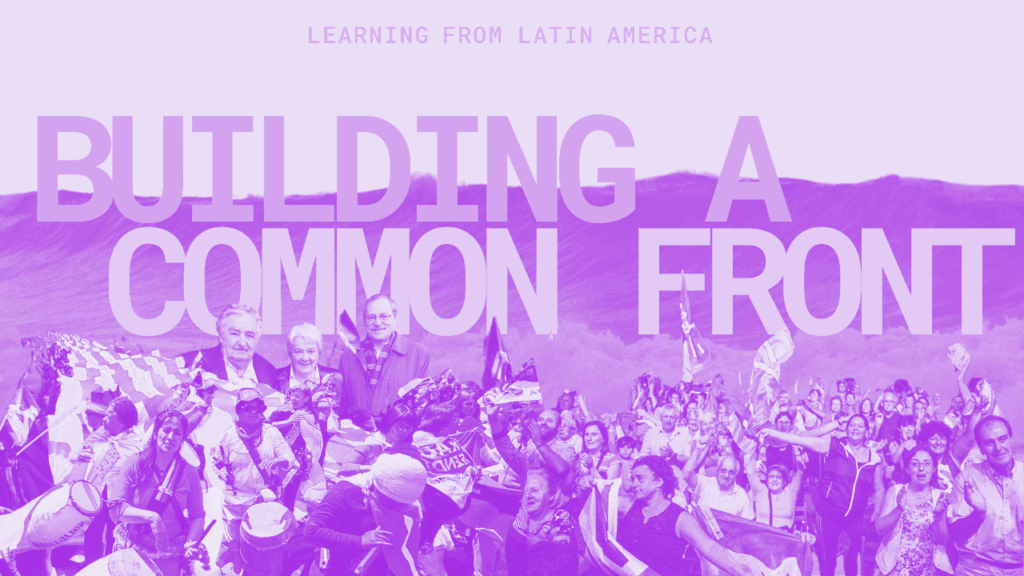After some months in the climate justice movement I went to one of the By 2020 We Rise Up conferences. This was in 2019 in Nuremberg, Germany. The aim of this platform wasto build a strategy for escalation and coordination of the climate justice movement. I had previous experiences in international work, but it was my first time in an international grassroots and climate justice space. I was nervous.
I had the unrealistic expectation of thousands of people having complex discussions and consequential agreements on how we would stop the fossil fuel industry, one of the pillars of capitalism, in the short term. On the first day I realized we were just dozens of people. At the end of the first day it struck me that although several people had the motivation, we lacked the ambition and the skills, leading to superficial conversations.
I looked around the room in panic. Something needed to be done. The facilitation team was trying their best and struggling. I understood that my fights back home to stop oil and gas projects were meaningless if there wasn’t an international plan to stop climate collapse. We needed to build a plan. My panic and anxiety led me to the conclusion that if this was an urgent task, anyone that would attempt at it would be good enough to try. I joined the core team of By 2020 We Rise Up.
Since then I have been doing international work. Five years went by. I attended and organised hundred of meetings, conferences, decentralized and centralized actions, and a variety of coordination spaces at regional, European and global level.
So this is where I am coming from.
We are still far way from where we need to be.
We need to learn faster and make new mistakes. That’s my goal with this article. I will start by exposing and exploring some of the different spaces I was more involved in, to then dive into what I identify as the major pitfalls of coordination spaces.
By 2020 We Rise Up – 2018 to 2020, European level
Escalation and coordination of the climate justice movement in Europe in 2020
|
The Scope and Aim |
Waves of coordinated and decentralized actions on specific weeks all over Europe during 2020, that united different groups under a common narrative and with similar targets, allowing for bigger political and economic impact. |
|
The Structure |
A campaign, with a core group of facilitators of the space to which any group can join and there is no endorsements or explicit commitment to be part of the campaign. Any group could join the action moments as well as the conferences, having access to the debates happening and a vote in decision making (mainly using consensus). |
|
The Outcomes |
3 European decentralized action waves. Several conferences that allowed to build trust, training new activists and create a space to discuss strategy at European level. There is a good evaluation document done by the core team here. |
|
The End |
In the end of 2020 the campaign ended. Groups either returned to the initial network where the campaign was created (Climate Justice Action); joined the Glasgow Agreement space (see below) or stopped doing international work. |
For me the most interesting part of this experience was the flexibility it had to adapt to external changes. Independently of all the previous planning two major happenings shaped the end of 2019 and the 2020 year: I) the boom of Extinction Rebellion actions and the Fridays for Futures marches; II) the COVID-19 pandemic.
On both situations, the platform was able to respond and to become a key element in the movement ecology. Let me elaborate.
Extinction Rebellion (XR) and Fridays for Future (FFF)were growing exponentiallyduring 2019. With them, a lot of new people showed up, full of energy and motivation but lacking organizational and strategical skills. Moreover, in most countries there were clashes between these new groups and the previously existing grassroots, mainly due to the lack of class perspective of the former, and the lack of urgency and honesty about their failures of the latter. The core team quickly understood the role that the platform could have: being an international platform to coordinate actions between different groups and with a neutral facilitation team, it had the ability to create a emotionally neutral space for dialogue and collaboration. It was able to join XR groups, FFF groups and grassroots in the same table and giving a common framing to all. It also gave tools and a movement perspective to the new people.
This flexibility and on-boarding of a lot of new groups and people was possible because there was no clear boundary of who was part of the campaign. Being part of it just meant coming to conferences or participating in moments of action. There was no prior agreement, only a tactical agreement to carry out a joint moment of action. This allowed groups with different ideologies and strategies to participate, according to their interests and campaigns. The major disadvantage of this approach is that we were never able to establish a real commitment between the groups and also between groups and the platform. In practice, this meant the following: to every meeting new groups came and some previous groups dropped out without notice, so there was no accountability towards the space and there wasn’t a sense of ownership.
The other major event that impacted this platform was the lock-down due to COVID-19 that paralyzed the whole climate justice movement in Europe. We just had four days of in-person strategy meeting with 200 people, made ambitious action plans for the upcoming Spring and Summer. We got back home. Next week, no one could go out of their houses, it was the beginning of lock-down in Europe.
Facing this, the platform launched online meetings for the climate justice European movement, in order to give cognitive, emotional and organizational support to the groups during rapidly changing conditions. These allowed to maintain connections, learning from each other, trying new tactics under that lockdown and processing what was happening. Most groups joined and keep participating for some time. The creation of this emergency space was possible because the platform was established and respected. The major pitfall of this moment was that, although it gave support, it did not gave a strategic perspective and lost connection with the ambition of escalating. While claiming to be anti-capitalist and saying that this system is killing us, we decided to believe that the same system would be able to solve the health and care crisis and we stopped taking political action. Unlike many other places around the world, Europe, particularly the European climate movement, paralyzed. This is something we cannot allow to happen again.
The last point I would like to stress is the pros and cons of having a “neutral” core team or facilitation team. Most of the people on it weren’t leading a specific group, so their main focus was to maintain and facilitate the platform. On the one hand, this allowed a perceived impartiality from the groups participating in the space. On the other hand, the facilitators were disconnected from the bases and strategic group thinking so they could not understand what were good or bad proposals to be made in the space. Lastly, not addressing that an anticapitalist platform couldn’t be “neutral”: as a result, we ended up being led by the mainstream ideas, with hidden clashes between different theories of change that could be much better navigated if handled explicitly.
The main conclusion from this experiences was that clear boundaries of the space and theory of change were needed to enable the commitment, agility and accountability for long term strategy.
Glasgow Agreement – 2019 to 2022, Global level
|
The Scope and Aim |
Global coordination space, with an anti-capitalist, feminist and anti-colonialist agreement, with the task of cutting emissions directly, not by asking governments to do it, but by taking the task into their own hands. The strategy was that each territory would do an inventory of the emitting infrastructures so we could have a map of all the major infrastructures and the companies involved in different countries. Then, create a political and action agenda, built from the local to the global, on how to cut emissions in each territory based on social justice and direct action. The global agenda would include different campaigns and actions. Doing this also meant organizations would be accountable with each other for cutting the emissions. |
|
The Structure |
Written agreement which each group needed to agree to join. The global assemblies were the major political and strategical space and then there were working groups to execute the decisions made in the global assemblies. Each organization could only be in 2 working groups and with maximum of 3 people in each, in order to balance power. There were also regional and national spaces with their own meetings and working groups, that worked with the global working groups. |
|
The Outcomes |
250 organizations signed, 7 territories did an inventory, no peoples agenda was ever finished. We held 3 regional conferences, 4 global conferences and had some global action moments and international campaigns. It allowed for several political and strategical discussions between groups, building relations still present today. |
|
The End |
After 2 years the space died due to the lack of commitment of the groups. Only 2 specific campaigns that carried on at slow pace: Collapse Total and This is Our Story. |
The space managed to bring together hundreds of groups with influence in their contexts. Its decline was justified by several organisations as technical difficulties in making the inventory and practical difficulties in getting the agenda off the ground, as well as due to COVID-19 (the agreement began to be built at the beginning of 2020 and was signed at the end of 2020). Some global activities were carried out and different tactics were tested.
There was considerable resistance to the culture of being accountable for actual cuts being made and/or progress being made in stopping new projects. The main reasons for this were: i) not wanting to be honest about how badly current strategies are falling short; ii) the clash of Western culture, which is based on quantification, with other cultures of organizing with more emphasis on people’s power; iii) groups that were doing the most economic disruption (despite the focus of the Glasgow agreement being on political and social impact) not reporting back properly.
Most organisations signed the agreement like people sign a petition (or like governments signed the Paris agreement). In practice, they had no intention of implementing the agreements or did not have a serious internal conversation within their organisation about how this would shape their strategy. They were unwilling to adjust their priorities and strategies in response to input from other groups or decisions by the global assembly.
The conclusion was that we needed to build a space with a common task but without a clear strategy and then set the strategies together.
Earth Social Conference – 2022 to 2023, Global level
|
The Scope and Aim |
A conference to boycott the Climate Summits (COP), forcing groups to take a clear stance on that companies and governments will not stop the climate crisis and on the need to create a space for organizations, who want move beyond advocacy, to come together and build plans of their own. |
|
The Structure |
We created teams and structure with a very specific agreement – building the conference – but through this several political and strategic conversations happened. On the build up for the conference, an open process of proposal and collective construction was created, to understand what type of global coordination space would be launched at the conference. |
|
The Outcomes |
One can read the wrap up of the conference here. |
|
The End |
There was a commitment to create the next conference to boycotting the COP, this time in Mexico in 2024. However, that process was latter taken over again by a much more moderate political line: they set the dates to not coincide with COP, allowing groups to “be both inside and outside COP”. This was accepted by the leading organizations with outside-the-system transformative strategy as their approach is to ignore COPs altogether and therefore they wouldn’t see a need for a confrontation of power in that terrain. Therefore, it become yet another conference that happens. |
All mainstream organizations, even the ones very critical of COP, decided to not boycott it since they are fully integrated in the process. Since these are the organizations with the most infrastructure capacity and resources, it was very difficult to find the money to pull this off, specially for travels. At the same time, this reality allowed to set a clear boundary that excluded inside-the-system transformative strategy from the Earth Social Conference. That allowed for the participation of mainly not inside-the-system groups. Clearer boundaries therefore allowed for more robust space but also showed the structural weaknesses of radical groups in the climate justice movement.
Several groups committed to work on international coordination for system change, while cutting emissions, by 2030. However, since it was a conference, there wasn’t any accountability space after it finished to keep account of this commitment as well as any learning coming from it.
***
Before diving in lessons, let’s look at more ongoing international platforms and alliances.
There are a number of international campaigns that focus on a specific targets or issue and which organise groups around it. These have been campaigns on specific and achievable end goals, such as stopping a particular project, or that have the ultimate aim of changing perceptions and what is accepted internationally on a particular issue. The vast majority of these campaigns have a professional core group focused solely on managing the platform, accompanied by a network of organisations involved that are activated at certain key moments.
When saying these, I’m thinking of examples like Beyond Gas and gastivists (both an international network led by NGOs advocating against fossil gas projects), Stay Grounded (similar but against aviation industry) and Block Gas or Strike WEF (international moments of action and counter conference against a big conference of the aggressors). These are some of the international spaces that I have actively participated and had strategy discussions in.
These spaces provide support for the movement, guaranteeing continuity in key struggles, a space for articulating very different strategies and tactics and the mutual exchange between groups. On the other hand, the core group, because they are often staff focused solely on the platform, are disconnected from organising and mobilising people and have an interest in the continuation of the platform rather than ensuring that it becomes obsolete as quickly as possible, with victories or defeats.
***
What are the pitfalls from coordination spaces
From the different experiences above I have drawn five main lessons on how to build coordination spaces.
Learning and adapting to context
I helped to create several spaces and saw many others being created. My understanding is that even when we try to build on past experience we tend to romanticize them while also not adapting their lessons to the current context.
Maybe one of the most visible moments I had about it was in 2022, when I was in Florence in a conference aiming to revitalize the European Social Forum and possibly the World Social Forum. I was expecting to hear honest conversation about what worked and not, and what was needed currently. In the end, the proposal was to replicate the same project done before. The problem is that, even if it was perfect back then, we are now looking for an answer to work in a different time and space. The movement and reality have changed. So the answer cannot be repeating the same procedure. Which leads us to the tension between tasks and process.
Task precedes structure
After three days of the World Congress for Climate Justice, a plenary took place. Three hundred people in the room. A proposal was made to create the First International of Climate Justice. For what? No one knew. The ambition is praiseworthy but a space created without an aim or a clear strategy is an empty space. Several people were complaining back then about the lack of process to create such a space. Definitely, the process wasn’t clear.
However, even if the perfect process existed, it wouldn’t have solved the basic problem. To get a better sense, let’s look at another attempt to build an international platform: the European Peoples’ Platform Conference in Vienna in 2024. The process was very well done: several meetings before, delegations, readings to prepare, small groups discussions, etc. Nevertheless, the same confusion and lack of commitment and engagement happened in the end. The problem was that there was no clarity on what the platform was for. The task precedes structure and process.
Deciding the task is the first step, then we can come to an understanding of the level of agreement needed in the space to deliver that task.
Clarity on the level of agreement (the four organizational layers) and the task to deliver
There are two agreements that need to be done in a coordination space: What the task is and what the organizational agreement is. Not all spaces need to have an ideological agreement or to restrict themselves at the tactical level. One needs nevertheless to have clarity on what is the level of the existing agreements and why so, in order to work in a healthy and agile way. One also needs to accept that it’s not possible to change the level of agreement without transforming the space entirely, which will result in opt-outs or loss of focus. Read more about the four organizational layers, here.
The level of the organizational agreement will depend on the specific task of the specific space. Lack of clarity on this leads to conflicting expectations and frustration of all members. Such clarity also gives a sense of the level of flexibility and commitment of the space.
If you create a campaign to fight against coal that is a tactical alliance against specific projects, it will allow for really different actors, with different strategies and even opposite theories of change and ideologies. This allows for a lot more participation, but it will be almost impossible for that platform to have the internal consensus about other political topics or to shift to different strategies at any given moment. At the same time, if the group agreement is at a higher level it allows for less participation but also for quick changes of focus and strategies.
After setting the layer, you need to look at relations.
Navigating in different cultures
Working with other organizations means working with different cultures. That means that you need to focus more in the tasks and relations and less on doing the process exactly as you want.
Trying to push for a specific way of doing it might loose focus on why you are doing and with whom you need to be doing it with. Saying this, it’s important to have clarity of what are the agreements on the space that you really need to do and why.
Another important point is the separation from what are regional cultures and organizational cultures, understanding what they are perpetuating. This implies not assuming what specific terms mean, what specific gestures mean, etc.. It’s important to accept that there will be different cultural and organizational experiences that will not fit in with yours, and navigate them.
Nevertheless, organizational cultures are related to the political and ideological areas where you are coming from, and it’s not about geographies or identities. These are crucial to comprehend. Sometimes, you have similar cultural connections with a group from a different culture that aligns with you, even from the same region, but which have a different ideological background. This means that the flexibility about different culture organization will depend of the scope of the space.
One of the major points of discussion around culture is how the space approaches power. About this, I have a final point I want to share with you.
The top-down power in a bottom-up approach (not doing global due to power dynamics)
One of the things always present in coordination spaces is the balance between top-down or bottom-up. There is a misconception in our minds that sets local as the bottom and global as the top.
It is true that, in many situations around us, the global decisions are being made by a small and closed group of people, then enforced on all of us. Yet in a globalized world, where we have a global working class against a globally articulated capitalist class, the people we are fighting with are the global working class. Decisions about strategic priorities in Switzerland can’t just be made on the basis of what the Swiss working class needs, but what the global working class needs (including from Switzerland). At the same time, a strategy defined in a North American regional space needs to be actively influenced and changed by South America and many other regions that are directly impacted by decisions made in North America. Otherwise, a formally bottom-up approach actually looks much more like a replica of the top-down status quo, where the capitalist core sets the agenda and reproduces the imperial power dynamics. This is not a useful approach for global strategizing.
A global coordination space where each member represents the interest of their base and where the strategy of each member can be influenced by all the others, is bottom-up. A global coordination space can also allow for a more honest and conscious management of power dynamics within the global movement.
And now what?
We need a ruptural, glocally coordinated movement (which can have sub-coordination levels). We don’t have time to repeat the same mistakes from the past. I hope this learning can support any future spaces being created to do new, bold and improved mistakes. Building a movement-as-party implies that different coordination spaces will be needed, with different agreements, that learn from each other and from the past, and whose aim is to bring the whole movement to execute its task.
Mariana Rodrigues is the co-author of All In.








